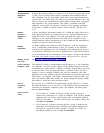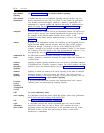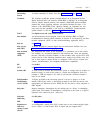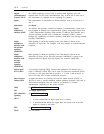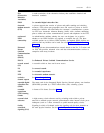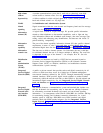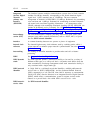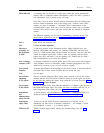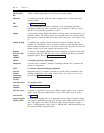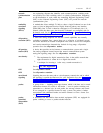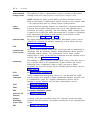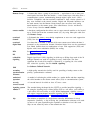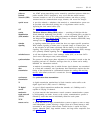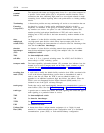
GLOSSARY GL-13
ISDN SID-ANI
LATA
LFA
link-access
procedure on
the D-channel
(LAPD)
local exchange
company (LEC)
Look-Ahead
Interflow
LOS
loss of frame
alignment
(LFA) alarm
loss of signal
(LOS) alarm
maintenance
and
administration
panel (MAAP)
maintenance
object (MO)
MEGACOM
®
A capability that can provide to a called party either the station identification
number (SID) or automatic number identification (ANI). The SID is passed as
user information; ANI is passed via the call setup.
If the SID is used to access internal network information about the calling party,
the user obtains information such as the calling party’s location, name, office
number, and type of telephone — information that is administered on the
communications system. ANI can be used to retrieve records such as customer
accounts, field service records, and sales records, that are indexed by telephone
number.
The SID/ANI capability can be used in telemarketing, customer service, and
other business applications. See also automatic number identification and
station identification number.
Local access and transport area.
See loss of frame alignment.
A link-layer protocol on the Integrated Services Digital Network basic rate
interface (ISDN-BRI) and primary rate interface (ISDN-PRI) data-link layer
(level 2). LAPD provides data transfer between two devices, and error and flow
control on multiple logical links. LAPD is used for signaling and low-speed
packet data (X.25 and mode 3) on the signaling (D-) channel and for mode-3
data communications on a bearer (B-) channel.
A company franchised to provide public intra-LATA (local access and transport
area) telephone service to subscribers within a defined geographical area. Also
called a local exchange carrier or local telephone company.
A feature that enhances the forwarding of calls from a vector so that calls will be
forwarded only to those remote locations that can accept the calls.
Loss of signal.
The loss of frame alignment (RFA) alarm, when received at the far end switch,
indicates that the near end switch is unable to frame up on the signal sent by the
far end (the end sending this alarm). Also called the red alarm. See also remote
frame alarm and loss of signal.
The loss of signal (LOS) alarm indicates that there is no bipolar signal present at
the ISDN-PRI receiver input. This alarm will occur in parallel with the loss of
frame alignment (LFA) alarm. See also remote frame alarm.
A device used by service technicians to administer a DIMENSION
®
PBX or a
System 85. See also visual maintenance and administration panel.
A term used by the AT&T Services organization for a unit that can be
maintained. An MO can be a hardware component — for example, a circuit
card, telephone, or trunk — or a software process.
AT&T's tariffed digital WATS offering for outward calling. See also 800
service.



